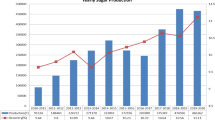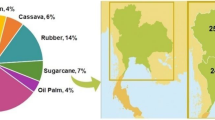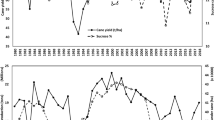Abstract
The South African Sugarcane Research Institute (SASRI) is a leading agricultural research institute and the only one of its kind in Africa conducting research into the development of new varieties, improving crop management and farming systems to enhance sugarcane productivity. In addition, effective delivery of new knowledge and technology make a significant contribution to the sustainability of the sugar industry in southern Africa. Variety Improvement and Crop Protection are key focus areas of research that have embraced modern molecular technologies to advance both conventional breeding and integrated control of pests and diseases.
Similar content being viewed by others
References
Assefa Y, Mitchell A, Conlong DE (2006) Phylogeography of Eldana saccharina Walker (Lepidoptera: Pyralidae). Ann Soc Entomol Fr 42(3–4): 331–337.
Barnard RO, Buys AJ, Coetzee JGK, Du Prees, CC Meyer JH, van Vuuren JAJ (1990) Handbook of standard soil testing methods for advisory purposes SASEX, Mount Edgecombe, South Africa
Bekker J (2007) Genetic manipulation of the cell wall composition of sugarcane. PhD Thesis, Stellenbosch University (Supervisors: JM Kossmann and J-H Groenewald).
Berry S (2007) Diversity and dynamics of plant parasitic nematode communities of sugarcane in South Africa: repercussion to the crop. Ph.D Thesis, University de Montpellier II, France. pp.220.
Berry S, Fargette M, Morand S, Cadet P (2007) Reliability of PCR-based techniques for detection and discrimination of plant-parasitic nematodes of sugarcane. Nematology 9(4): 499–514.
Beyer L, Wachen-Dorf C, Balzer F, Balzer M, Graf UC (1992) The use of biological methods to determine microbial activity of soils under cultivation. Biol Fertil Soils 13: 242–247.
Bindon KA, Botha FC (2001) Tissue disks as an experimental system for metabolic flux analysis in the sugarcane culm. SA J Bot 66: 260–264.
Bindon KA, Botha FC (2002) Carbon allocation to the insoluble fraction, respiration and triose-phosphate cycling in the sugarcane culm. Physiologia Plantarum 116: 12–19.
Bosch S, Grof CPL, Botha FC (2004) Expression of neutral invertase in sugarcane. Plant Sci 166: 1125–1133.
Botha FC (2007) Precision breeding to improve the usefulness of sugarcane. Proc Int Soc Sugar Cane Technol 26: 35–43.
Botha FC, Black KG (2000) Sucrose phosphate synthase and sucrose synthase activity during maturation of internodal tissue in sugarcane. Aust J Plant Physiol 27: 81–85.
Bower R, Elliott AR, Potier BAM, Birch RG (1996) High-efficiency microprojectile-mediated cotransformation of sugarcane, using visible or selectable markers. Molec Breeding 2: 239–249.
Braithwaite KS, Egeskov NM, Smith GR (1995) Detection of sugarcane bacilliform virus using the polymerase chain reaction. Plant Dis 79:792–796.
Butterfield MK, Thomas DW (1996) Sucrose, yield and disease resistance characteristics of sugarcane varieties under test in the SASEX selection programme. Proc S Afr Sug Technol Assoc 70: 103–105.
Butterfield MK, D’Hont AD, Berding N (2001) The sugarcane genome: a synthesis of current understanding, and lessons for breeding and biotechnology. Proc S Afr Sug Technol Ass 75: 1–5.
Butterfield MK, Keeping MG, Sewpersad C (2007) Estimating genetic parameters and the efficiency of molecular breeding for resistance to the stalk borer Eldana saccharina. Proc Int Soc Sugar Cane Technol 26: 691–698.
Butterfield MK, Rutherford RS, Carson DL, Huckett BI (2004) Application of gene discovery to varietal improvement in sugarcane. S A J Bot 70: 167–172.
Cadet P, Spaull VW (2005) Nematode parasites of sugarcane. In: M Luc, RA Sikora and J Bridge J (eds), Plant parasitic nematodes in subtropical and tropical agriculture. Wallingford, CAB International, pp 645–674.
Carson DL, Botha FC (2000) Preliminary analysis of Expressed Sequence Tags for sugarcane. Crop Sci 40: 1769–1779.
Carson DL, Botha FC (2002a) Genes expressed in sugarcane maturing internodal tissue. Plant Cell Reports 20: 1075–1081.
Carson DL, Botha FC (2002b) Sugarcane ESTs differentially expressed in immature and maturing internodal tissue. Plant Sci 162: 289–300.
Carson DL, Huckett BI, Botha FC (2002) Differential gene expression in sugarcane leaf and internodal tissue of varying maturity. S A J Bot 68: 434–442.
Dominy CS, Haynes RJ, van Antwerpen R (2001) Long-term effects of sugarcane production on soil quality in the South Coast and Midlands areas of KwaZulu Natal. Proc S Afr Sug Technol Ass 75: 222–227.
Gallo-Meagher M, Irvine JE (1996) Herbicide resistant transgenic sugarcane plants containing the bar gene. Crop Sci 36: 1367–1374.
Gilbert RA, Gallo-Meagher M, Comstock JC, Miller JD, Jain M, Abouzid A (2005) Agronomic evaluation of sugarcane lines transformed for resistance to sugarcane mosaic virus strain E. Crop Sci 45: 2060–2067.
Gill AT, Snyman SJ, Potier BAM, Huckett BI (2004) Towards antibiotic resistance free transgenic sugarcane. Proc S Afr Sug Technol Ass 78: 163–166.
Govindarajan M, Balandreau J, Muthukumarasamy R, Revathi G, Lakshminarasimhan C (2006) Improved yield of micropropagated sugarcane following inoculation by endophytic Burkholderia vietnamiensis. Plant Soil 280: 239–252
Graham MR, Haynes RJ, Zelles L, Meyer JH (2001) Long-term effects of green cane harvesting versus burning on the size and diversity of soil microbial community. Proc S Afr Sug Technol Ass 75: 228–234.
Groenewald J-H, Botha FC (2001). Manipulating sucrose metabolism with a single enzyme: pyrophosphate-dependent phosphofructokinase (PFP) Proc S Afr Sug Technol Ass 75: 101–103.
Groenewald J-H, Botha FC (2007a) Down-regulation of pyrophosphate: fructose 6-phosphate 1-phosphotransferase (PFP) activity in sugarcane enhances sucrose accumulation in immature internodes. Transgenic Res 17: 85–92.
Groenewald J-H, Botha FC (2007b) Molecular and kinetic characterisation of sugarcane pyrophosphate: fructose-6-phosphate 1-phosphotransferase (PFP) and its possible role in the sucrose accumulation phenotype. Functional Plant Biol 34: 517–525.
Grof CPL, Campbell JA (2001) Sugarcane sucrose metabolism: scope for molecular manipulation. Aust J Plant Physiol 28: 1–12.
Guyon S, Vogel JL, Omarjee J, Van Antwerpen T, Cadet P, Balandreau J (2003) Burkholderia tropica, a potential bacterial inoculant to control nematodes and improve sugarcane growth. Proc S Afr Sug Technol Ass 77: 118–123.
Heinze BS, Thokoane LN, Williams NJ, Barnes JM, Rutherford RS (2001) The smut-sugarcane interaction as a model system for the integration of marker discovery and gene isolation. Proc S Afr Sugar Technol Ass 75: 88–93.
Hoepfner SW, Botha FC (2003) Expression of fructokinase isoforms in the sugarcane culm. Plant Physiol Biochem 41: 741–747.
Hoepfner SW, Botha FC (2004) Purification and characterization of fructokinase from the culm of sugarcane. Plant Sci 167: 646–654.
Ingelbrecht IL, Irvine JE, Mirkov TE (1999) Posttranscriptional gene silencing in transgenic sugarcane. Dissection of homology-dependent virus resistance in a monocot that has a complex polyploid genome. Plant Physiol 119: 1187–1197.
Jeyaprakash A, Hoy MA (2000) Long PCR improves Wolbachia DNA amplification: wsp sequences found in 76% of sixty-three arthropod species. Insect Molec Biol 9: 393–405.
Leibbrandt NB, Snyman SJ (2001) Initial field testing of transgenic glufosinate ammonium-resistant sugarcane. Proc S Afr Sug Technol Ass 75: 108–111.
Leibbrandt NB, Snyman SJ (2003) Stability of gene expression and agronomic performance of a transgenic herbicide-resistant sugarcane line in South Africa. Crop Science 43: 671–677
McCormick AJ, Cramer MD, Watt DA (2006) Sink strength regulates photosynthesis in sugarcane. New Phytol 171: 759–770.
McCormick AJ, Cramer MD, Watt DA (2007) Changes in photosynthetic rates and gene expression of leaves during a source-sink perturbation in sugarcane. Ann Bot, (in press).
McFarlane SA, Rutherford RS (2005) Fusarium species isolated from sugarcane in KwaZulu-Natal and their effect on Eldana saccharina (Lepidoptera: Pyralidae) development in vitro. Proc S Afr Sug Technol Ass 79: 120–124.
Meyer GM, Banasiak M, Ntoyi TT, Nicholson TL, Snyman SJ (2007) Sugarcane plants from temporary immersion culture: acclimating for commercial production. Acta Hort (in press).
Moor B, St. C, Hudson JR (2007) The South African sugar industry: shaped by history. Sugar Industry / Zuckerindustrie 132(6): 425–432.
Moore PH (1995) Temporal and spatial regulation of sucrose accumulation in sugarcane. Aust J Plant Physiol 22: 661–679.
Moore PH (2005) Integration of sucrose accumulation processes across hierarchical scales: towards developing an understanding of the gene-to-crop continuum. Field Crops Res 92: 119–135.
Murashige T, Skoog F (1962) A revised medium for rapid growth and bio assays with tobacco tissue cultures. Physiol Plant 15: 473–497.
O’Donnell K, Kistler HC, Cigelnik E, Ploetz RC (1998) Multiple evolutionary origins of the fungus causing Panama disease of banana: Concordant evidence from nuclear and mitochondrial gene genealogies. Proc Natl Acad Sci USA 95: 2044–2049.
O’Reilly G (1998) The South African sugar industry. Int Sug J 100: 266–268.
Omarjee J (2006). Interactions between Burkholderia populations and sugarcane growth. Ph.D Thesis. University of Claude Bernard, Lyon, France. pp 255.
Omarjee J, van Antwerpen T, Balandreau J, Kuniata L, Rutherford S (2004) Isolation and characterization of some endophytic bacteria from Papua New Guinea sugarcane. Proc S Afr Sug Technol Ass 78: 189–193.
Pillay L, McFarlane SA, Rutherford RS (2005) A preliminary report on genetic diversity in populations of sugarcane rust in KwaZulu-Natal. Proc S Afr Sug Technol Ass 79: 132–136.
Rohwer JM, Botha FC (2001) Analysis of sucrose accumulation in the sugarcane culm on the basis of in vitro kinetic data. Biochem J 358: 437–445.
Rose S, Botha FC (2000) Distribution patterns of neutral invertase and sugar content in sugarcane internodal tissues. Plant Physiol Biochem 38: 819–824
Rossouw D, Bosch S, Kossmann JM, Botha FC, Groenewald J-H (2007) Down-regulation of neutral invertase activity in sugarcane cell suspension cultures leads to increased sucrose accumulation. Functional Plant Biol 34: 490–498.
Rutherford RS, Brune AE, Nuss KJ (2004) Current status of research on sugarcane yellow leaf syndrome in southern Africa. Proc S Afr Sug Technol Ass 78: 173–180.
Rutherford RS, van Antwerpen T, Conlong DE, Keeping MG, McFarlane SA, Vogel JL (2002) Promoting plant health: potential for the use of plant associated microorganisms in the biological control of pathogens and pests in sugarcane. Proc S Afr Sug Technol Ass 76: 289–300.
Schäfer WE, Rohwer JM, Botha FC (2004a) A kinetic study of sugarcane sucrose synthase. Eur J Biochem 271: 3971–3977.
Schäfer WE, Rohwer JM, Botha FC (2004b) Protein-level expression and localization of sucrose synthase in the sugarcane culm. Physiologia Plantarum 121: 187–195.
Schäfer WE, Rohwer JM, Botha FC (2005) Partial purification and characterization of sucrose synthase in sugarcane. J Plant Physiol 162: 11–20.
Smith GR, Van de Velde R, Dale JL (1994) PCR amplification of a specific double-stranded RNA region of Fiji disease virus from diseased sugarcane. J Virol Meth 39:237–246.
Snyman SJ (2004) Transformation of sugarcane. In: IS Curtis (ed), Transgenic Crops of the World-Essential protocols. Kluwer Academic Publishers. pp 103–114.
Snyman SJ, Black KG, Huckett BI, Watt MP (1992) Towards a gene transfer system for sugarcane (Saccharum spp. hybrids). Proc S Afr Sug Technol Ass 66: 29–37.
Snyman SJ, Huckett BI, Botha FC, Watt MP (2001a) A comparison of direct and indirect somatic morphogenesis for the production of transgenic sugarcane (Saccharum sp. hybrids). Acta Hort 560: 105–108.
Snyman SJ, Monosi BB, Huckett BI (2001b) New developments in the production of herbicide-resistant sugarcane. Proc S Afr Sug Technol Ass 75: 112–114.
Snyman SJ, Meyer GM, Carson D, Botha FC (1996) Establishment of embryogenic callus and transient gene expression in selected sugarcane varieties. S Afr J Bot 62:151–154.
Snyman SJ, Meyer GM, Richards JM, Haricharan N, Ramgareeb S, Huckett BI (2006) Refining the application of direct embryogenesis in sugarcane: effect of the developmental phase of leaf disc explants and the timing of DNA transfer on transformation efficiency. Plant Cell Reports 25: 1016–1023.
Snyman SJ, van Antwerpen T, Ramdeen V, Meyer GM, Richards JM, Rutherford RS (2007) Micropropagation by direct somatic embryogenesis: is disease elimination also a possibility? Proc Int Soc Sugar Cane Technol 26: 943–946.
Snyman SJ, Watt MP, Huckett BI, Botha FC (2000) Direct somatic embryogenesis for rapid, cost effective production of transgenic sugarcane (Saccharum spp hybrids). Proc S Afr Sug Technol Ass 74: 186–187.
Sooknandan S, Snyman SJ, Potier BAM, Huckett BI (2003) Progress in the development of mosaic resistant sugarcane via transgenesis. Proc S Afr Sug Technol Ass 77: 624–627.
Spaull VW (1995) A revised estimate of crop loss in sugarcane caused by nematodes. Proc S Afr Sug Technol Ass 69: 28–34.
Telschow A, Hammerstein P, Werren JH (2002) The effect of Wolbachia on genetic divergence between populations: Models with two-way migration. American Naturalist 160: S54–S66.
Thokoane LN, Rutherford RS (2001) cDNA-AFLP differential display of sugarcane (Saccharum spp, hybrids) genes induced by challenge with the fungal pathogen Ustilago scitaminae (H&P Sydow) (sugarcane smut). Proc S Afr Sugar Technol Ass 75: 104–107.
Torsvik V, Daae FL, Sandaa RA, Ovreas L (1998) Review article: novel techniques for analysing microbial diversity in natural and perturbed environments. J Biotechnol 64: 53–62.
Turner W, Botha FC (2002) Purification and kinetic properties of UDP-glucose dehydrogenase from sugarcane. Archives of Biochemistry and Biophysics 407: 209–216.
Uys L, Botha FC, Hofmeyr J-H S Hofmeyr, Rohwer JM (2007) Kinetic model of sucrose accumulation in maturing sugarcane culm tissue. Phytochem 68: 2375–2392.
van Antwerpen T, Botha FC (1999) Development of a DNA-based diagnostic method to detect sugarcane bacterial pathogens with emphasis on Clavibacter xyli subsp xyli. Proc S Afr Sug Technol Ass 73:128–133.
van Antwerpen T, Bailey RA, Subramoney DS, McFarlane K, Rutherford RS, Nuss KJ (2005) Eighty years of sugarcane quarantine in South Africa. Sugar Cane International 24(2): 9–12.
van Antwerpen T, Rutherford RS, Vogel J (2002) Assessments of sugarcane endophytic bacteria rhizosphere Burkholderia species as antifungal agents. Proc S Afr Sug Technol Ass 76: 301–304
van Antwerpen T, van Antwerpen R, Meyer JH, Naidoo P, Berry S, Spaull VW, Govender K, Cadet P, Rutherford R, Laing MD (2007) Factors associated with healthy soil in sugarcane production in Kwa-Zulu Natal. Proc Int Soc Sugar Cane Technol 26: 273–279.
Vogel J L, Balandreau J, van Antwerpen T, Dana P, Cadet P (2002) Isolation and characterisation of sugarcane rhizobacteria and their effect on nematodes. Proc S Afr Sug Technol Ass 76: 305–309
Vorster DJ, Botha FC (1998) Partial purification and characterisation of sugarcane neutral invertase. Phytochem 49: 651–655.
Vorster DJ, Botha FC (1999) Sugarcane internodal invertases and tissue maturity. J Plant Physiol 155: 470–476.
Watt DA (2003) Aluminium responsive genes in sugarcane: identification and expression under oxidative stress. J Exp Bot 54: 1163–1174.
Watt DA, McCormick AJ, Govender C, Carson DL, Cramer MD, Huckett BI, Botha FC (2005) Increasing the utility of genomics in unraveling sucrose accumulation. Field Crops Res 92: 149–158.
Welbaum GE, Meizner FC (1990) Compartmentation of solutes and water and in developing sugarcane stalk tissue. Plant Physiol 93: 1147–1153.
Whittaker A, Botha FC (1997) Carbon partitioning during sucrose accumulation in sugarcane internodal tissue. Plant Physiol 115: 1651–1659.
Whittaker A, Botha FC (1999) Pyrophosphate: d-fructose-6-phosphate 1-phosphotransferase activity patterns in relation to sucrose storage across sugarcane varieties. Physiologia Plantarum 107: 379–386.
Withers LA (1988) Germplasm preservation. In: Applications of Plant Cell and Tissue Culture. Wiley and Sons, Sussex, pp 163–177.
Wu L, Birch RG (2007) Doubled sugar content in sugarcane plants modified to produce a sucrose isomer. Plant Biotech J 5: 109–117.
Author information
Authors and Affiliations
Corresponding author
Rights and permissions
About this article
Cite this article
Snyman, S.J., Baker, C., Huckett, B.I. et al. South African Sugarcane Research Institute: Embracing biotechnology for crop improvement research. Sugar Tech 10, 1–13 (2008). https://doi.org/10.1007/s12355-008-0001-5
Received:
Accepted:
Published:
Issue Date:
DOI: https://doi.org/10.1007/s12355-008-0001-5




